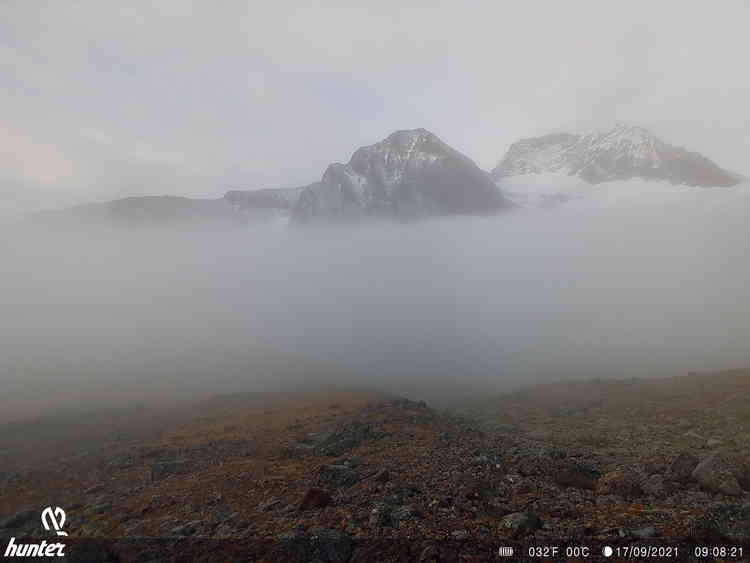Nina Kirchner, Annika Granebeck, Jamie Barnett, Linnea Huusko, Daniella Lillieroth Charalambous
This dataset contains images of Lake Tarfala taken daytime every 2 hours during the period from 17 September to 23 October 2021. During this period, the surface of Lake Tarfala transitions from being ice-free to ice-covered, an event referred to as "ice-on".
The dataset can be used to observe the ice-on event and to assign a date (or, rather, a time interval) to it. Knowledge of lake ice phenology, i.e. seasonal formation and loss of the lacustrine ice cover, is of importance since the timing of ice-on impacts lake processes such as stratification and vertical mixing.
The pictures were acquired using a camera positioned on the mountain flank along Lake Tarfala’s north-eastern shore, at 1220 m above sea level. In total, there are 235 images.
Download data

Scientific highlights
This dataset allows to assign a precise date to the ice-on event at Lake Tarfala in autumn 2021. Defining ice-on as the first occasion after the ice-free summer season on which the lake becomes completely ice-covered and remains so for the rest of the winter, it was attained on 19 October 2021.
Precise knowledge of the ice-on date can be used to:
- Assist in understanding lake mixing processes.
- Better constrain numerical models computing ice-on.
- Provide a complement to ice-on dates derived from satellite imagery, which is notoriously difficult in polar alpine environments due to persistent cloud cover and long polar nights.
- Lend support to alternative definitions of ice-on.
- Contribute to knowledge of lake ice phenology in high altitude Arctic environments under current climate change.
Some notable events in the time-lapse imagery of the establishing lake ice cover include:
Pre-ice-on
- 25 September: First occasion of thin ice layer formation on lake surface (at 07:08 until 11:08) and subsequent disintegration into large drifting ice floes (at 13:08 until 19:08). Repeated occurrence visible on central and northern parts of the lake, later drifting into the southeastern lake corner (16 October, at 09:08 until 13:08). Additional formation of a thin ice pattern occurs on 29 September (from 07:08), followed by breakup though melting (30 September, at 15:08 and 17:08).
- 4 October: Inflow of sediment-rich streamwater from stream network on the eastern lake bank (left margin of picture, most visible at 13:08). Repeated occurrence of the phenomenon can be seen on 10 October (at 09:08).
Ice-on
- 19 October: First occasion of clearly identifiable ice cover across the entire lake surface, subsequently snow covered (at 17:08 and forward).
- 20 – 21 October: Patterning of snow cover on frozen lake surface (e.g. 20 October at 15:08 and 21 October at 17:08).
- 23 October: Thickening of ice cover and establishment of continous overlying snow cover.
Note that the camera produces black-white images under certain light conditions, such as during dusk and dawn and under some low-visibility weather conditions.
Citation
Nina Kirchner, Annika Granebeck, Jamie Barnett, Linnea Huusko, Daniella Lillieroth Charalambous (2023) Time lapse imagery of the ice-on event at Lake Tarfala, Kebnekaise Mountains, northern Sweden, autumn 2021. Dataset version 1. Bolin Centre Database. https://doi.org/10.17043/tarfala-kirchner-2023-ice-on-2021-1
Data description
The dataset consists of image files (JPG) of Lake Tarfala, with the date and time (Swedish daylight saving time, UTC+2) included in each photo.
The pictures were acquired using a camera positioned on the mountain flank along Lake Tarfala’s north-eastern shore, at ~67.9° N, 18.6° E, at 1220 m above sea level.
The data were collected using a Hunter Orion Trail Camera 4G. The camera elevation is 1.8 m above ground. Each JPG file has a size of ~2.4 MB. The total size of the dataset is ~504 MB.
During a few short periods, fog, snow and/or rain obscures the view of the lake. Due to shorter periods of daylight during autumn, the number of dark images between dusk and dawn successively increased. These are therefore excluded from the dataset.
Comments
The support of our co-workers on the Arctic Avenue activity Lake thermal and mixing dynamics under changing climate (J. Weckström, K. Weckström, A. Korhola, and F. Schenk) is gratefully acknowledged.
